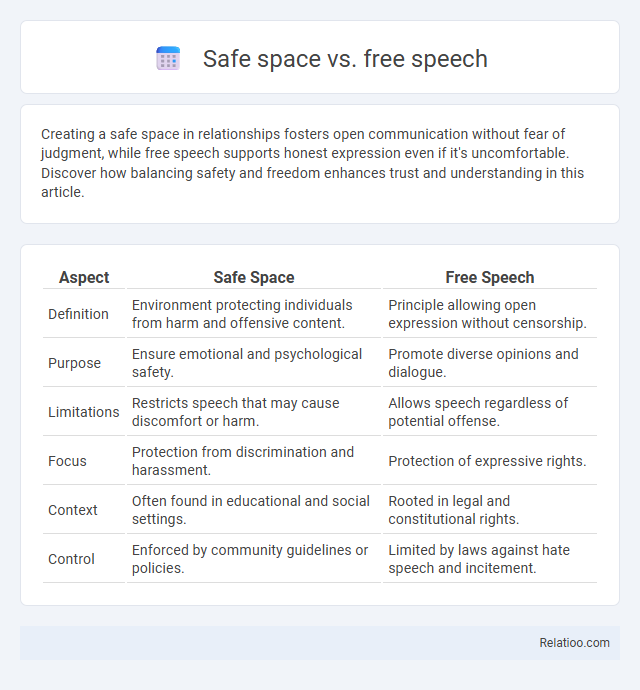Creating a safe space in relationships fosters open communication without fear of judgment, while free speech supports honest expression even if it's uncomfortable. Discover how balancing safety and freedom enhances trust and understanding in this article.
Table of Comparison
| Aspect | Safe Space | Free Speech |
|---|---|---|
| Definition | Environment protecting individuals from harm and offensive content. | Principle allowing open expression without censorship. |
| Purpose | Ensure emotional and psychological safety. | Promote diverse opinions and dialogue. |
| Limitations | Restricts speech that may cause discomfort or harm. | Allows speech regardless of potential offense. |
| Focus | Protection from discrimination and harassment. | Protection of expressive rights. |
| Context | Often found in educational and social settings. | Rooted in legal and constitutional rights. |
| Control | Enforced by community guidelines or policies. | Limited by laws against hate speech and incitement. |
Understanding Safe Spaces: Origins and Purpose
Safe spaces originated as supportive environments for marginalized groups to express themselves without fear of discrimination or harassment, promoting mental and emotional well-being. Your ability to engage in open dialogue is balanced with the need to protect individuals from harmful rhetoric, creating a respectful community. Understanding the purpose of safe spaces clarifies their role in fostering inclusion while recognizing the importance of free speech in diverse settings.
Defining Free Speech: Principles and Importance
Free speech is the fundamental right to express opinions without censorship or restraint, essential for fostering open dialogue, democracy, and societal progress. It safeguards diverse viewpoints, enabling individuals, including You, to challenge ideas and promote change while respecting legal boundaries against hate speech or incitement. Balancing free speech with safe spaces requires understanding its principles to protect expression while creating environments where all feel secure and respected.
Historical Context: Balancing Safety and Expression
The historical context of safe spaces and free speech reveals ongoing tension between protecting marginalized voices and ensuring open expression. Safe spaces emerged as environments where individuals can express themselves without fear of discrimination or harm, responding to social movements advocating equality and mental health awareness. Your challenge lies in balancing these protective environments while upholding the foundational free speech principles that safeguard democratic dialogue and diverse perspectives.
The Debate: Safe Space vs Free Speech on Campus
The debate over safe spaces versus free speech on campus centers on balancing students' psychological well-being with their right to express diverse opinions. Advocates of safe spaces emphasize creating environments where marginalized groups feel protected from harassment and discrimination, promoting inclusivity and mental health. Opponents argue that unrestricted free speech is fundamental to academic freedom and intellectual growth, cautioning that overly restrictive safe spaces can lead to censorship and hinder open discourse.
Impact on Academic Freedom
The balance between safe space and free speech significantly influences academic freedom by shaping the environment in which ideas are exchanged and challenged. Safe spaces aim to protect individuals from harm and create inclusive settings, potentially limiting controversial speech and restricting open debate, which can hinder academic inquiry. Conversely, prioritizing free speech fosters a climate where all viewpoints, including unpopular or challenging ones, are explored, essential for robust academic freedom but may risk alienating marginalized groups.
Legal Perspectives: Rights and Limitations
Legal perspectives on safe spaces and free speech highlight a balance between protecting individuals from harassment and upholding First Amendment rights. Your right to express opinions is safeguarded by law, but institutions can enforce policies that restrict speech to prevent harm and maintain respectful environments. Courts often weigh these limitations against constitutional freedoms, ensuring both safety and free expression coexist within legal boundaries.
Social Media and the Safe Space/Free Speech Divide
Social media platforms grapple with balancing safe spaces and free speech, as users demand environments free from harassment while advocating for unrestricted expression. Your online experience relies on nuanced content moderation policies that aim to protect vulnerable communities without infringing on open dialogue. This delicate divide requires continuous refinement to ensure social networks foster both inclusivity and robust conversations.
Psychological Effects: Protection vs Restriction
Safe spaces provide psychological protection by creating an environment where individuals feel secure from discrimination and emotional harm, fostering mental well-being. Free speech, while essential for open dialogue, can sometimes lead to exposure to offensive or harmful expressions, potentially causing stress or anxiety. Balancing these concepts involves weighing the protective benefits of safe spaces against the possible restrictions on expression, impacting psychological comfort and freedom.
Strategies for Harmonizing Safe Spaces and Free Speech
Strategies for harmonizing safe spaces and free speech involve creating clear community guidelines that respect diverse perspectives while fostering inclusivity. Implementing moderated dialogue and active listening techniques helps ensure that all voices are heard without fear of harassment or discrimination. Balancing these elements requires ongoing education and collaboration to promote mutual respect and constructive conversations.
Case Studies: Lessons from Recent Controversies
Case studies such as the 2017 CUNY Struggle event and the 2018 Evergreen State College protests highlight tensions between safe space policies and free speech principles, revealing the complexities in balancing inclusive environments with open dialogue. Analysis of these incidents shows that overly rigid safe space enforcement can marginalize dissenting views, while unchecked free speech may foster environments of hostility. These lessons emphasize the need for nuanced policies that protect vulnerable groups without stifling constructive debate.

Infographic: Safe space vs Free speech
 relatioo.com
relatioo.com